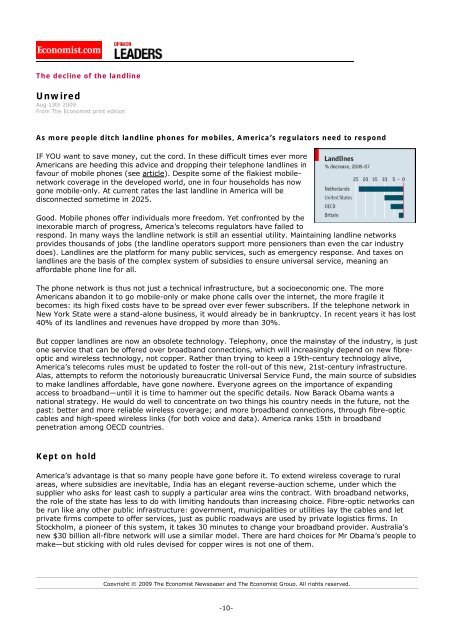Untitled - the ultimate blog
Untitled - the ultimate blog
Untitled - the ultimate blog
Create successful ePaper yourself
Turn your PDF publications into a flip-book with our unique Google optimized e-Paper software.
The decline of <strong>the</strong> landline<br />
Unwired<br />
Aug 13th 2009<br />
From The Economist print edition<br />
As more people ditch landline phones for mobiles, America’s regulators need to respond<br />
IF YOU want to save money, cut <strong>the</strong> cord. In <strong>the</strong>se difficult times ever more<br />
Americans are heeding this advice and dropping <strong>the</strong>ir telephone landlines in<br />
favour of mobile phones (see article). Despite some of <strong>the</strong> flakiest mobilenetwork<br />
coverage in <strong>the</strong> developed world, one in four households has now<br />
gone mobile-only. At current rates <strong>the</strong> last landline in America will be<br />
disconnected sometime in 2025.<br />
Good. Mobile phones offer individuals more freedom. Yet confronted by <strong>the</strong><br />
inexorable march of progress, America’s telecoms regulators have failed to<br />
respond. In many ways <strong>the</strong> landline network is still an essential utility. Maintaining landline networks<br />
provides thousands of jobs (<strong>the</strong> landline operators support more pensioners than even <strong>the</strong> car industry<br />
does). Landlines are <strong>the</strong> platform for many public services, such as emergency response. And taxes on<br />
landlines are <strong>the</strong> basis of <strong>the</strong> complex system of subsidies to ensure universal service, meaning an<br />
affordable phone line for all.<br />
The phone network is thus not just a technical infrastructure, but a socioeconomic one. The more<br />
Americans abandon it to go mobile-only or make phone calls over <strong>the</strong> internet, <strong>the</strong> more fragile it<br />
becomes: its high fixed costs have to be spread over ever fewer subscribers. If <strong>the</strong> telephone network in<br />
New York State were a stand-alone business, it would already be in bankruptcy. In recent years it has lost<br />
40% of its landlines and revenues have dropped by more than 30%.<br />
But copper landlines are now an obsolete technology. Telephony, once <strong>the</strong> mainstay of <strong>the</strong> industry, is just<br />
one service that can be offered over broadband connections, which will increasingly depend on new fibreoptic<br />
and wireless technology, not copper. Ra<strong>the</strong>r than trying to keep a 19th-century technology alive,<br />
America’s telecoms rules must be updated to foster <strong>the</strong> roll-out of this new, 21st-century infrastructure.<br />
Alas, attempts to reform <strong>the</strong> notoriously bureaucratic Universal Service Fund, <strong>the</strong> main source of subsidies<br />
to make landlines affordable, have gone nowhere. Everyone agrees on <strong>the</strong> importance of expanding<br />
access to broadband—until it is time to hammer out <strong>the</strong> specific details. Now Barack Obama wants a<br />
national strategy. He would do well to concentrate on two things his country needs in <strong>the</strong> future, not <strong>the</strong><br />
past: better and more reliable wireless coverage; and more broadband connections, through fibre-optic<br />
cables and high-speed wireless links (for both voice and data). America ranks 15th in broadband<br />
penetration among OECD countries.<br />
Kept on hold<br />
America’s advantage is that so many people have gone before it. To extend wireless coverage to rural<br />
areas, where subsidies are inevitable, India has an elegant reverse-auction scheme, under which <strong>the</strong><br />
supplier who asks for least cash to supply a particular area wins <strong>the</strong> contract. With broadband networks,<br />
<strong>the</strong> role of <strong>the</strong> state has less to do with limiting handouts than increasing choice. Fibre-optic networks can<br />
be run like any o<strong>the</strong>r public infrastructure: government, municipalities or utilities lay <strong>the</strong> cables and let<br />
private firms compete to offer services, just as public roadways are used by private logistics firms. In<br />
Stockholm, a pioneer of this system, it takes 30 minutes to change your broadband provider. Australia’s<br />
new $30 billion all-fibre network will use a similar model. There are hard choices for Mr Obama’s people to<br />
make—but sticking with old rules devised for copper wires is not one of <strong>the</strong>m.<br />
Copyright © 2009 The Economist Newspaper and The Economist Group. All rights reserved.<br />
-10-








![[ccebbook.cn]The Economist August 1st 2009 - the ultimate blog](https://img.yumpu.com/28183607/1/190x252/ccebbookcnthe-economist-august-1st-2009-the-ultimate-blog.jpg?quality=85)



![[ccebook.cn]The World in 2010](https://img.yumpu.com/12057568/1/190x249/ccebookcnthe-world-in-2010.jpg?quality=85)
![[ccemagz.com]The Economist October 24th 2009 - the ultimate blog](https://img.yumpu.com/5191885/1/190x252/ccemagzcomthe-economist-october-24th-2009-the-ultimate-blog.jpg?quality=85)